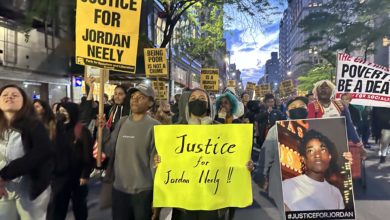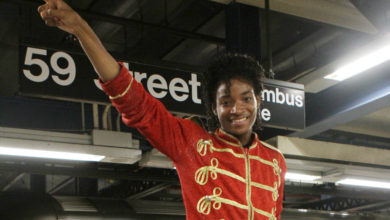Till’s murder catalyzed the Civil Rights movement to courageously defy the segregation system to which he had fallen victim. Photo from Mamie Till Bradley.
On August 28, 1955, 14-year-old Emmett Till was abducted from the home of his uncle, Moses Wright, in Money, Mississippi. Three days later, Till’s body was found in the Tallahatchie River. He had been dumped there, weighed down by a 74-pound cotton gin fan tied to his neck with barbed wire. His face was entirely beaten in, one ear was missing, there was a bullet hole through his right temple, and all his right teeth had been knocked out. Till’s uncle was able to identify his nephew only by spotting a ring on his hand.
Crime without punishment
What could young Till, a native of Chicago, possibly have done to provoke such an attack? In Mississippi visiting friends and family, he had merely taken a dare to ask a white woman for a date. After buying bubble gum in Bryant’s Grocery & Meat Market, Till flirted with the woman at the register, Carolyn Bryant. She chased him from the store. On the way out, he was said to have whistled at her.
A few days later, Carolyn’s husband, Roy, and his half-brother, J.W. Milam, learned of the incident and decided to hunt down Till. In the middle of the night, they abducted and beat him mercilessly before finally killing him.
Their act stood out not simply for its inhumanity and savagery but as a violent warning to all those who dared defy the apartheid social order of the Southern states.
Milam and Bryant were indicted on murder charges. A grand jury in Greenwood, Mississippi, refused to bring charges of kidnapping against the two, although they had admitted to the abduction. Their trial began September 19. It ended four days later after an all white jury, deliberating for a mere hour and seven minutes, delivered a “not guilty” verdict.
The verdict reinforced what was generally understood in the South—that Black people had no rights that whites were bound to respect. In a 1956 interview in Look Magazine, the two men admitted to the crime. They claimed to have decided to kill Till—initially wanting “only” to kidnap and beat him—after they dragged him into the woods and he stated that the picture of a white girl in his wallet was his girlfriend.
Despite their confession, double jeopardy laws prevented a second trial, and the two remained free until their deaths. No one ever did a day in prison for the murder of Emmett Till.
State complicity
Local, state and federal governments were key instruments in maintaining segregation, a system of complete domination that made it possible for the super-exploitation of Black workers. The governmentally-protected system did not give particular economic benefits to poor whites, but by offering them a higher social caste, it encouraged and emboldened their intense bigotry.
Vigilante violence and groups such as the Ku Klux Klan—which could not have functioned without the complete complicity and participation of the state—enforced the segregated social order. In the Till case, state complicity manifested itself in various ways.
First, the sheriff deliberately held two key witnesses in the county jail for two weeks in order to prevent their testimony. The two had been with Milam and Bryant the night of the crime.
Secondly, in the Till trial—as with the 1963 trial of Byron Delay Beckwith for the murder of Medgar Evers—the jury pool was picked from the rolls of registered voters. Since African Americans were disenfranchised by Jim Crow voting laws at the time, every jury ended up being all white. For any Black person on trial, a “trial of one’s peers” was an empty phrase. Every jury had its share of bigots.
Thirdly, the “hands off” approach of the federal government allowed these injustices to become the codified norm. In Washington, powerful Southern senators and congressmen used their influence to dissuade the government from intervening on behalf of African Americans, which would upset the economic and political dominance of their friends and backers. Legally, the federal government could have intervened; it could have retried the men on the basis that the first trial had been illegitimate. The Justice Department had the power to prosecute public officials and law enforcement officers who obstructed justice and conspired in incidents of racist violence. But it did nothing.
The people did respond, however. The Montgomery bus boycott three months later is widely recognized as the beginnings of the Civil Rights movement. But even earlier, the wrenching images of Till’s mutilated body stirred the consciousness of the country, Black and white.
New trials ahead?
Recently, the federal government decided to reopen the case of Emmett Till. The Federal Bureau of Investigation claims it may be able to obtain information that could lead to the prosecution of individuals not implicated in the first trial.
The reopening of the case is certainly a positive development. Anyone culpable in the killing, the cover-up or the impropriety of the trial should be tried for their crimes.
It is not sufficient, however, to count on the state to fight violent racists. Even today, the courts and prisons in capitalist society still serve only the ruling class. This is clear in the case of political prisoners like the Cuban Five, Mumia Abu-Jamal, Leonard Peltier and many others.
The state prosecutes and sentences people of color more harshly than white people convicted of equal crimes. Racist vigilantes like the Minutemen still go unpunished. Police officers frequently brutalize and murder Black and Latino youth, without ever facing jail time.
Racism is deeply rooted in the capitalist system and its courts. In 1955, each branch of the government acted as an accomplice to Roy Bryant and J.W. Milam. Real justice in Emmett Till’s case doesn’t end with indicting the individuals who contributed to his death. It will be achieved when the racist system that protected them and profited from apartheid segregation is torn down.






